Idiosyncratically tuned switching behavior of riboswitch aptamer domains revealed by comparative small-angle X-ray scattering analysis
- PMID: 20106958
- PMCID: PMC2822924
- DOI: 10.1261/rna.1852310
Idiosyncratically tuned switching behavior of riboswitch aptamer domains revealed by comparative small-angle X-ray scattering analysis
Erratum in
- RNA. 2010 Jul;16(7):1447
Abstract
Riboswitches are structured mRNA elements that regulate gene expression upon binding specific cellular metabolites. It is thought that the highly conserved metabolite-binding domains of riboswitches undergo conformational change upon binding their cognate ligands. To investigate the generality of such a mechanism, we employed small-angle X-ray scattering (SAXS). We probed the nature of the global metabolite-induced response of the metabolite-binding domains of four different riboswitches that bind, respectively, thiamine pyrophosphate (TPP), flavin mononucleotide (FMN), lysine, and S-adenosyl methionine (SAM). We find that each RNA is unique in its global structural response to metabolite. Whereas some RNAs exhibit distinct free and bound conformations, others are globally insensitive to the presence of metabolite. Thus, a global conformational change of the metabolite-binding domain is not a requirement for riboswitch function. It is possible that the range of behaviors observed by SAXS, rather than being a biophysical idiosyncrasy, reflects adaptation of riboswitches to the regulatory requirements of their individual genomic context.
Figures

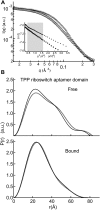

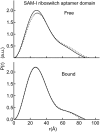
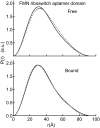
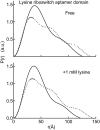
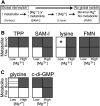
Similar articles
-
Riboswitch function: flipping the switch or tuning the dimmer?RNA Biol. 2010 May-Jun;7(3):328-32. doi: 10.4161/rna.7.3.11932. Epub 2010 May 30. RNA Biol. 2010. PMID: 20458165 Free PMC article. Review.
-
Free state conformational sampling of the SAM-I riboswitch aptamer domain.Structure. 2010 Jul 14;18(7):787-97. doi: 10.1016/j.str.2010.04.006. Structure. 2010. PMID: 20637415 Free PMC article.
-
Multiple conformations of SAM-II riboswitch detected with SAXS and NMR spectroscopy.Nucleic Acids Res. 2012 Apr;40(7):3117-30. doi: 10.1093/nar/gkr1154. Epub 2011 Dec 1. Nucleic Acids Res. 2012. PMID: 22139931 Free PMC article.
-
Riboswitch conformations revealed by small-angle X-ray scattering.Methods Mol Biol. 2009;540:141-59. doi: 10.1007/978-1-59745-558-9_11. Methods Mol Biol. 2009. PMID: 19381558 Free PMC article.
-
Structural studies of the purine and SAM binding riboswitches.Cold Spring Harb Symp Quant Biol. 2006;71:259-68. doi: 10.1101/sqb.2006.71.015. Cold Spring Harb Symp Quant Biol. 2006. PMID: 17381305 Review.
Cited by
-
Molecular dynamics re-refinement of two different small RNA loop structures using the original NMR data suggest a common structure.J Biomol NMR. 2012 Aug;53(4):321-39. doi: 10.1007/s10858-012-9642-5. Epub 2012 Jun 20. J Biomol NMR. 2012. PMID: 22714631 Free PMC article.
-
The impact of a ligand binding on strand migration in the SAM-I riboswitch.PLoS Comput Biol. 2013;9(5):e1003069. doi: 10.1371/journal.pcbi.1003069. Epub 2013 May 16. PLoS Comput Biol. 2013. PMID: 23704854 Free PMC article.
-
Tertiary contacts control switching of the SAM-I riboswitch.Nucleic Acids Res. 2011 Mar;39(6):2416-31. doi: 10.1093/nar/gkq1096. Epub 2010 Nov 19. Nucleic Acids Res. 2011. PMID: 21097777 Free PMC article.
-
Comparison of solution and crystal structures of preQ1 riboswitch reveals calcium-induced changes in conformation and dynamics.J Am Chem Soc. 2011 Apr 13;133(14):5190-3. doi: 10.1021/ja111769g. Epub 2011 Mar 16. J Am Chem Soc. 2011. PMID: 21410253 Free PMC article.
-
Role of lysine binding residues in the global folding of the lysC riboswitch.RNA Biol. 2015;12(12):1372-82. doi: 10.1080/15476286.2015.1094603. RNA Biol. 2015. PMID: 26403229 Free PMC article.
References
-
- Baird NJ, Westhof E, Qin H, Pan T, Sosnick TR. Structure of a folding intermediate reveals the interplay between core and peripheral elements in RNA folding. J Mol Biol. 2005;352:712–722. - PubMed
-
- Batey RT, Gilbert SD, Montange RK. Structure of a natural guanine-responsive riboswitch complexed with the metabolite hypoxanthine. Nature. 2004;432:411–415. - PubMed
-
- Chauhan S, Caliskan G, Briber RM, Perez-Salas U, Rangan P, Thirumalai D, Woodson SA. RNA tertiary interactions mediate native collapse of a bacterial group I ribozyme. J Mol Biol. 2005;353:1199–1209. - PubMed
-
- Dann CE, III, Wakeman CA, Sieling CL, Baker SC, Irnov I, Winkler WC. Structure and mechanism of a metal-sensing regulatory RNA. Cell. 2007;130:878–892. - PubMed
-
- Edwards TE, Ferré-D'Amaré AR. Crystal structures of the thi-box riboswitch bound to thiamine pyrophosphate analogs reveal adaptive RNA-small molecule recognition. Structure. 2006;14:1459–1468. - PubMed
Publication types
MeSH terms
Substances
Grants and funding
LinkOut - more resources
Full Text Sources
Other Literature Sources
